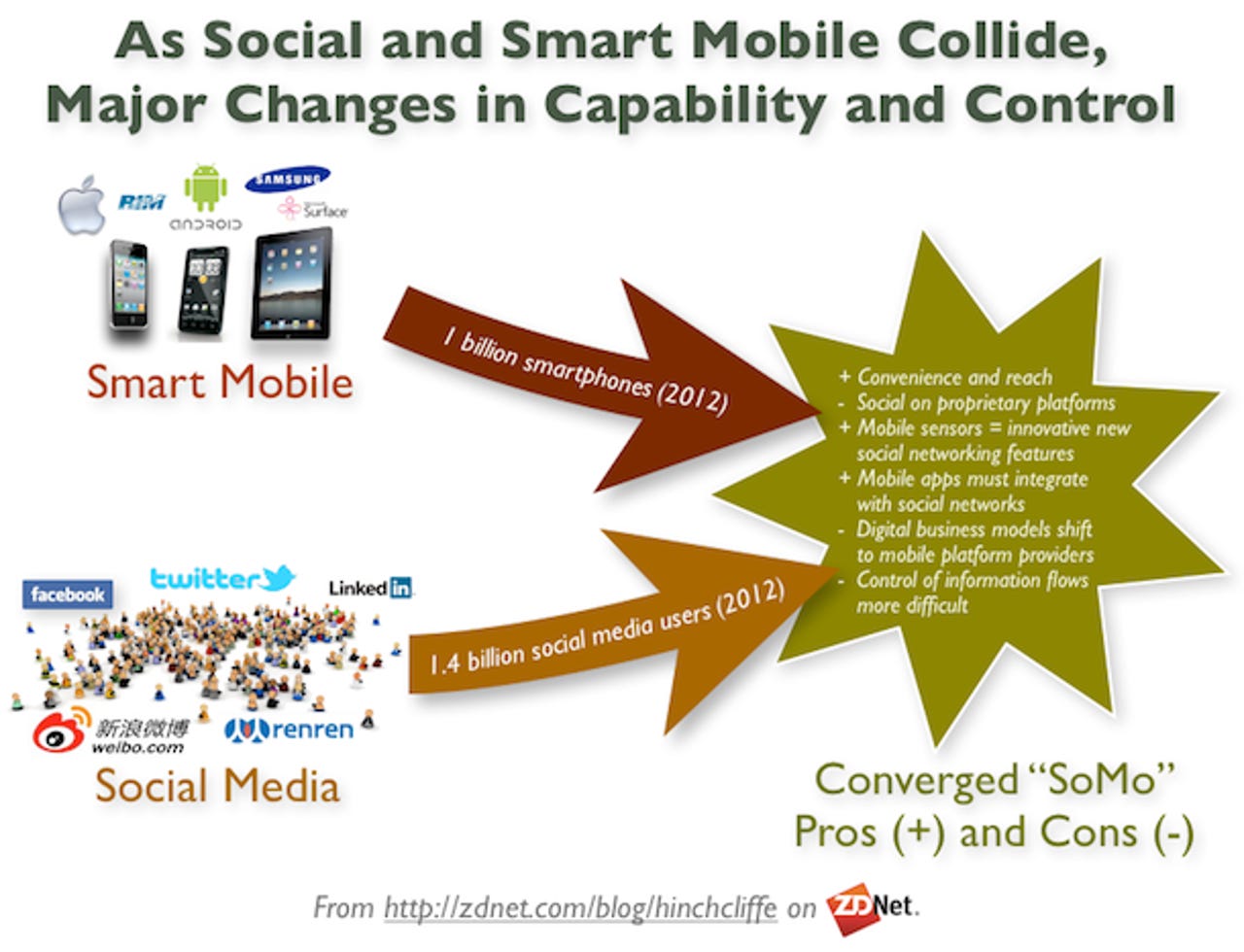The convergence of mobile and social: The next IT battleground

The numbers speak for themselves when it comes to the recent mass migration of the global population to smartphones and social media. The majority of the developed world now uses both, with just over a billion smart device users worldwide currently according to estimates, and approximately 1.4 billion users of social media by the end of this year. Many of these users are also in developing nations, and have begun to employing a combination of mobile devices and social media to realize significant -- and occasionally momentous and inspired -- changes to the world around them.
In terms of meaningful real-world impact of these technologies, mass self-organizing activity of all types has been enabled and greatly amplified by social media, mobile devices, or increasingly both (see Arab Spring, Kony 2012, SOPA, the Nigerian Constitution, and many other recent examples.) The reach of today's global mobile and social networks, combined with motivated users and applications that explicitly tap into what makes them uniquely effective (read: the fundamental power laws of networks) are creating a growing level of genuine change in the status quo of politics, society, culture, government, and business. Though certainly, there's still quite a journey ahead.
The root causes of this mass collaboration phenomenon are deep and tied directly to the relentless pervasiveness of new types of networked devices and applications. Now a second shoe seems to have fallen as well and it's a crucial one: The world at large is starting to wake up to the fact that we're all connected together, continuously, to everyone else in the world. What's more, we're now figuring out ways to optimize and make the very most of this fact, one almost certainly unique in all human history.
Geography, cost, time, discoverability, and even language have largely fallen as significant obstacles to communicating and collaborating with everyone in the world. Or perhaps more importantly, at scale, with any community in the world.

Both social and smart mobile devices have directly had a large hand in reducing these barriers to practically zero because of their innate network effects and ease-of-use. Mobile apps and app stores have also done much to put the powerful new services in everyone's hands, while social media has simultaenously connected the world's population together in ways we almost entirely craft ourselves, to such an extent now that the Web itself is perhaps at risk of becoming outmoded as the most important global venue for information.
The impact of smart mobility and social on the enterprise
These same changes, as far as they sometimes seem from the halls of our local IT department, has long been taking place in our organizations, though they're more pronounced now than ever. I've explored in the past the topic of shadow IT, a fast growing phenomenon best described as the cloud becoming a more appealing and far easier place to source applications, information, and just about anything else one needs to get work done. Rather than going through official channels to get what you neeed, that is. Browser-based applications (SaaS, Web apps), search engines, app stores, and social networks are just a few examples of channels far, far larger, richer, and more useful when they're outside the organization, as opposed to to the local and often quite limited technology landscape of the typical organization, even today.
Related: Shifting IT delivery to tablets: The strategic issues
It's no wonder then that Gartner predicts that over a third of all IT will come directly from such sources soon, rather than official corporate IT channels. Businesses must adapt to an increasingly fast pace of technology change, which in turn is pushing the business world to change more quickly as well. Specificially, this ranges from an onslaught of competitive new products and services to how customers are marketed to, sold, and supported. Business users are tapping into the best technology resources they have to drive local improvements, and this includes the latest and most popular channels where the world is spending time (for example, social is now the #1 activity online as of 2012.)
Organizations looking to stay current and relevant are scrambling to address the current and near-future digital landscape, which will be the primary way most companies engage with their customers, workers, and even their supply chain. I've dubbed such proactive organizations next-generation enterprises, which are companies that don't wait for disruption but seek out and add each new major technology development as a key tool to improve how they exchange value with the world. As part of this adoption challenge, mobile and social have now become top concerns for many companies this year, even if they're unsure how to best apply them to their business.
Mobile and social colliding as much as cooperating
However, it may not be so easy to reconcile the current state of smart mobile devices with social media. Never mind that a large percentage of mobile apps are already social (with sharing buttons and close integration with Facebook, Twitter, Dropbox, etc.) Most organizations ignore the increasingly vast array of sensors in smart mobile devices that makes it even easier for the social applications collapse space and transport the real-world over the network in useful ways. I see that most business overlook the fact that mobile devices are essentially based on proprietary platforms that we have little control over. All of these are key issues with mobile/social convergence.
In fact, I'm surprised by how many companies still block Facebook (up to 67% by some estimates) and Twitter, essentially driving their workers onto their own IT systems -- usually mobile devices -- to talk with customers, prospects, industry colleagues, and co-workers in social channels. (Though in countries like China, social networks such as Weibo and Renren are more relevant, but not yet a prime integration target of mobile platforms vendors.)
Related: Will Apple's partner approach trump Google in mobile?
But despite the growing of integration of social networks into the operating systems of mobile devices -- Apple is the leader here with support for Twitter, Facebook, Yelp, and others -- there is a number of fundamental issues in conflict that have significant implications for companies that must make the shift to mobile and social in a way that preserves what matters most to them. Yet, even though I see the shift to mobile as the #1 priority with most CIOs currently -- there's not always a full appreciation of the extent to which social is intertwined with it.
Top 6 implications of mobile/social convergence
For those tracking the collision of social and mobile, here seem to be the biggest issues:
- Convenience and reach. Mobile devices will soon become the main way that people use social networks. Your enterprise social strategy, both internally and externally, should now be mobile-first, even though you can't forget legacy devices yet or even any time soon. To help, here is one of my most detailed explorations of how to reconcile social business and mobile service delivery.
- Challenges of social on proprietary platforms. Unlike the open standards of the Web, mobile applications are based on proprietary technology. Whether an organization is building its own apps or 3rd party apps, there will be a tension between the lack of standardization, platform lock-in, and vendor competition that will impact the openness and transparency that makes social media so effective. Facebook's difficulty in opening up its platform on mobile devices or engaging in effective advertising are good examples of such constraints.
- Mobile sensors will drive innovation and business value. Smart mobile devices aren't laptops that are lighter, they have a rich set of new sensors (compass, GPS, accelerometers, gyroscopes, multiple cameras, NFC, and more) with operating systems designed to take advantage of them. This can enable many interesting business scenarios such as multiple-point video chat ala Google Hangouts, transcripted recorded of meetings, voice integration with social media, and many other communication advances. While unified communication platforms are focusing on these even more than enterprise social media, both will ultimately take advantage of it to drive productivity internally and better engagement externally, such as with social customer care.
- Mobile apps integrated with social networks. Put simply, non-social apps are getting connected to social networks, mostly public ones for now, but also enterprise social networks when it makes sense (see my recent discussion on OpenSocial for details on how this is happening now with social -- but not mobile -- applications.) The IT world has recently learned that enterprises must connect their systems of record to their systems of engagement to get maximum benefit of both technologies. Unfortunately, mobile application integration with social networks has not yet progressed much beyond the OAuth phase and this is going to be a growing issue in keeping a level playing field.
- Digital business models shift to mobile platform providers. Those who own the platforms make the rules, and this has proven the case with mobile platforms when it comes to business models. App purchases, in-app purchases, advertising, and more are all under the strict control of Apple, Google, and other mobile platform owners. Those looking to monetize their mobile services will have to closely work with them, unlike the Web, where any business model that is legal (and sometimes otherwise) is potentially viable and under the control of who creates it. As companies seek to turn IT into a profit center and use new digital channels to operate their business, the vendor-imposed rules of mobile platforms are going to become a greater issue.
- Information flows more potent, yet harder to control in converged social/mobile. Social networks and mobile apps provide higher levels of reach and scale, yet makes it much harder to control the information that moves within and across them. As it was with Web 2.0, control of hard-to-create data will be as important as ever but even more challenging given how quickly and easily information can be spread, copied, and lost. Organizations will have to become ever better strategic data managers and experts in Big Data techniques to make the most of mobile and social channels.
The constraints yet enormous power of next-generation mobile platforms, combined with the shift to social channels -- both inside and outside of organizations -- is going to be a major test of IT departments, who have to do a double upgrade of their skills, technologies, infrastructure, architecture, and support capabilities to order to embrace both effectively.
In addition, and just as challenging for IT, the more profound and impactful benefits of social/mobile will ultimately come via the shift to digital business models that take tap into the mass self-organizing (aka social business) aspects I cited earlier. However, if organizations focus on the major issues -- most of which I believe are summarized above -- and are willing to invest appropriately, I believe mobile/social convergence will have limited negative impact and considerable upside. Those that ignore the issues, however, almost certainly have a painful learning curve ahead.
What issues are you running into as your organization goes mobile and social? Please share in Talkback below.